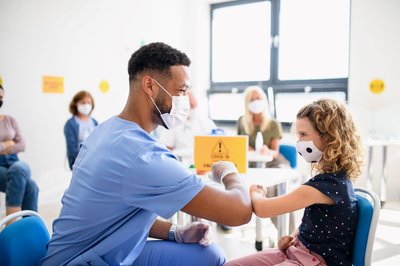National Preparedness Month: Ensuring children are part of the equation
- Published August 31, 2022

In disasters and emergencies, preparation at every level – from a family creating an emergency plan to hospital staff practicing disaster-response drills – adds up to better outcomes when crisis strikes.
But children’s needs aren’t always part of that equation: in 2013, the National Pediatric Readiness Project assessment found that only 47% of emergency departments have disaster plans that address children.
The Disaster Domain of the Emergency Medical Services Center for Children Innovation and Improvement Center (EIIC) focuses on helping health care providers, public health departments, schools, and families better prepare for disasters through learning opportunities and resources, such as the newly updated pediatric disaster preparedness checklist.
The domain and EIIC as a whole are key partners in the Pediatric Pandemic Network, which aims to turn children’s hospitals into regional hubs for pediatric disaster-related information, education, and resources, with support from diverse partners and participants. The network was inspired in part by the COVID-19 pandemic, which has underscored the need for a more coordinated and equitable approach to caring for children during major health emergencies.
“PPN ensures pediatric experts aren’t operating in echo chambers by bringing together children’s hospitals, academic institutions, and regional and national organizations,” says Charles Macias, MD, MPH, a co-principal investigator for EIIC and PPN. “We want everyone who cares for kids, whether in emergency departments, ambulances, schools, or homes, to have the knowledge and tools to address all children’s needs when planning for, responding to, and recovering from crises.”
PPN launched in September 2021 with federal funding from the Health Resources and Services Administration. The network started with five children’s hospitals in California, Kentucky, Missouri, Ohio, and Utah and three core partners: EIIC and two Pediatric Disaster Centers of Excellence, Western Regional Alliance for Pediatric Emergency Medicine (WRAP-EM) and Region V for Kids.
Beginning Sept. 1, the network will expand to include five more children’s hospital hubs and their communities. Through that growth, and through PPN’s partnerships with EIIC and the Pediatric Disaster Centers of Excellence, the network touches nearly every U.S. state and territory.
Recapping PPN’s first year
In honor of September as National Preparedness Month and the anniversary of the PPN’s funding announcement, here are some highlights from the network’s first year.
- Assembling 200+ staff and subject matter experts from across the country
- Launching a Disaster Networking Collaborative, a quality improvement workshop series focused on engaging children’s hospitals in regional disaster planning.
- Recruiting the first participants for the PPN Scholars, a development program for early career researchers.
- Educational resource development, including pediatric symptom cards for disaster trainings; infectious disease FAQs for health care providers; and a hospital-focused pediatric trauma toolkit and course.
- Presenting at the recent National Academies of Sciences, Engineering, and Medicine Symposium on Pediatric Disaster Science.
- Laying the foundation for a powerful analytics platform to support data-driven activities.
- Launching PPN’s initial web presence at pedspandemicnetwork.org.
In addition, last week, participants from across the network and its partners gathered for a three-day meeting in St. Louis. A major topic at the meeting was maximizing PPN’s impact through the 10 total children’s hospital hubs.
“Welcoming five more hospitals greatly expands the network’s reach, and also deepens PPN’s expertise in areas such as pandemics, equity, and education,” Macias says. “We’re thrilled about the opportunity to increase PPN’s impact as we work together to improve regional and national pediatric preparedness.”
Learn more about the PPN at pedspandemicnetwork.org.
About PPN’s partners
Hub sites:
University Hospitals Rainbow Babies & Children’s Hospital, Cleveland, OH (lead center)
- University of California San Francisco-Benioff Children’s Hospital, San Francisco, CA
- University of Louisville School of Medicine-Norton Children’s Hospital, Louisville, KY
- University of Utah, Primary Children’s, Salt Lake City, UT
- Saint Louis University-Cardinal Glennon Children’s Hospital, St. Louis, MO
Children’s National Hospital, Washington, DC (lead center)
- Ann & Robert H. Lurie Children’s Hospital, Chicago, IL
- Seattle Children’s Hospital, Seattle, WA
- University of Alabama at Birmingham-Children’s of Alabama, Birmingham, AL
- Children’s Mercy Hospital, Kansas City, MO
EIIC: EIIC aims to optimize outcomes for children across the emergency care continuum by leveraging quality improvement (QI) science and multidisciplinary, multisystem collaboration, including by offering products and programs that promote pediatric readiness in prehospital and hospital settings. EIIC’s partnership with PPN extends beyond the Disaster Domain, to include coordinated work on topics such as prehospital-based care and QI collaboratives. Learn more: emscimprovement.center.
Region V for Kids: One of the two current Pediatric Disaster Centers of Excellence, which are funded by the Administration for Strategic Preparedness and Response (ASPR), Region V for Kids brings together 10 children’s hospitals, along with other private and public entities, to address gaps in pediatric disaster care in a six-state region: Ohio, Michigan, Illinois, Indiana, Minnesota, and Wisconsin. The center’s participants bring expertise in multiple fields, including pediatric-focused disaster education, and hazard vulnerability analyses. Learn more: emscimprovement.center/domains/preparedness/asprcoe/eglpcdr.
WRAP-EM: The second of the two ASPR-funded Pediatric Disaster Centers of Excellence, WRAP-EM unites pediatric disaster experts, organizations, and hospitals across six states (Arizona, California, Nevada, Oregon, and Washington) in a collaborative effort to improve pediatric emergency response capabilities region-wide. WRAP-EM’s focus groups produces and share resources and events on pediatric mental health, legal issues, mass-casualty incidents, and more. Learn more: wrap-em.org.